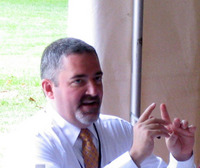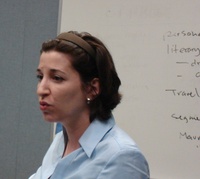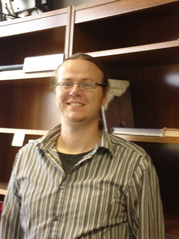 On October 4 this year, Dr. Trent Watts was a featured author at the Louisiana Book Festival in Baton Rouge, an all-day event in and around the outstanding 34-story Art Deco state capitol, where Huey Long was assassinated in 1935. The organizers of the festival invited Dr. Watts and a number of other authors, including novelists, poets, and non-fiction writers, to present panels at which they discussed their books before interested and enthusiastic public audiences. About 20,000 people came to hear the authors, watch cooking exhibitions, and listen to music ranging from zydeco and traditional fiddling to the Baton Rouge Symphony Orchestra.
On October 4 this year, Dr. Trent Watts was a featured author at the Louisiana Book Festival in Baton Rouge, an all-day event in and around the outstanding 34-story Art Deco state capitol, where Huey Long was assassinated in 1935. The organizers of the festival invited Dr. Watts and a number of other authors, including novelists, poets, and non-fiction writers, to present panels at which they discussed their books before interested and enthusiastic public audiences. About 20,000 people came to hear the authors, watch cooking exhibitions, and listen to music ranging from zydeco and traditional fiddling to the Baton Rouge Symphony Orchestra.
The event was very family-friendly, with lots of children’s authors reading their books. The organizers of the festival also brought three contributors to White Masculinity in the Recent South, a collection of essays edited by Dr. Watts and published by Louisiana State University Press. These authors appeared on the panel with Dr. Watts. These contributors are Ted Ownby, Susan Donaldson, and Chip Arnold, outstanding scholars and writers. After their discussion and questions from the audience, Dr. Watts and his colleagues signed books.
The Louisiana Book Festival is only six years old, but it’s already grown into one of the best events of its kind in the country. Everything about it was first-rate. The authors were picked up at the Baton Rouge airport in a limousine, which was a treat. The night before the event, the Louisiana Book Festival threw a party for the authors at the Louisiana State Library. A jazz ensemble played while they ate jambalaya, gumbo, shrimp, catfish, and lots of other good southern food.
On Saturday night Dr. Watts and his wife, Jennifer, skipped another author event to go out to dinner at a great Baton Rouge restaurant. Their driver (the event organizers thought of everything) was an LSU student. When Jennifer said that it was a shame they weren’t going to be able to see the LSU campus, the driver insisted on giving us a nighttime tour. The campus is gorgeous, with magnificent old oaks everywhere. When Dr. Watts wanted to see Tiger Stadium, where LSU plays football the driver insisted that they stop to meet Mike the Tiger, the school mascot. He’s a Bengal/Siberian mix who’s well on his way to the 700 pounds he’ll weigh when he’s fully grown. Mike lives next to the stadium in a 15,000 (yes, 15,000) square foot enclosure, complete with a stream, a waterfall, and an Italianate tower.
Trent says, “I wish Missouri had an event like this one. It’s a great opportunity to present one’s work to the public. It’s also a good place to meet other scholars. A fellow I met at the Friday night party has agreed to work with me on my next book project.”

